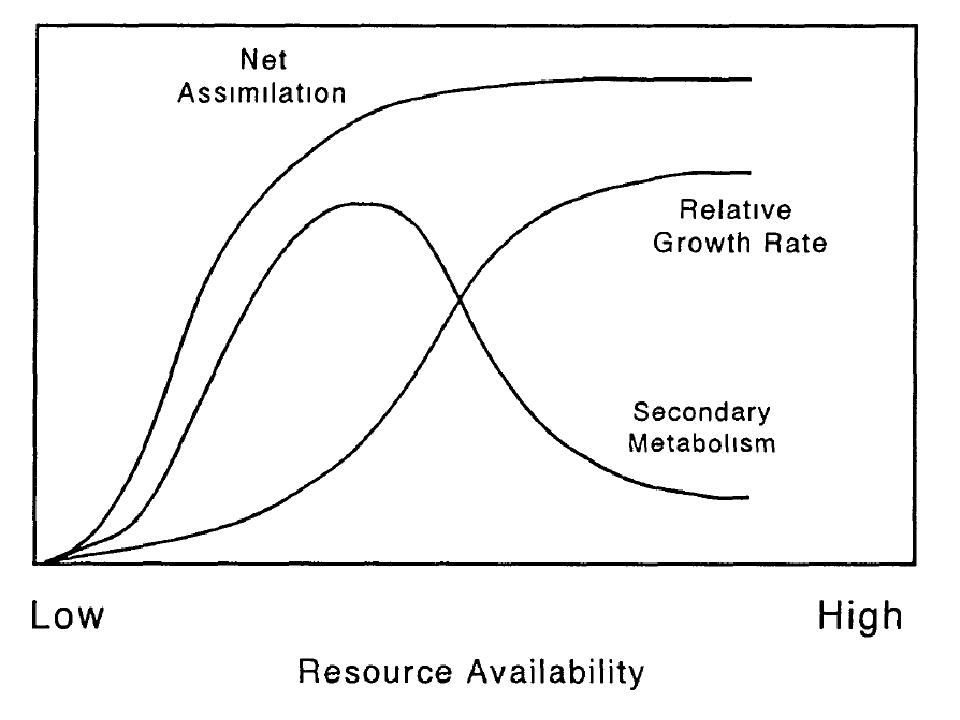Linda got a few comments and questions on her post a couple of weeks ago on fertilization and insect resistance. This is an issue I’ve been peripherally involved with over the years so I wanted to share a few thoughts. First, the relationship between plant nutrition and insect resistance is extremely complex. We often have difficulty predicting how a plant is going to respond to fertilization, let alone predict how an insect is going to respond to how the plant responded. I haven’t kept up but Koricheva (2002) reported over a dozen different theories have been proposed to explain insect response to plant nutrition. One of the factors that makes it difficult to generalize about plant/insect interactions is that various insects feed on different plant parts in different ways; some are leaf feeders, some suck sap, some bore into wood, some feed on seeds or cones. How an insect feeds can affect its response. To stick with an illustration I’m more familiar with, we can look at insect response to plant drought stress. Bark beetles are widely known to key in and attack pines and other conifers under drought stress but pine tip moths prefer succulent buds and new growth and are more likely to attack well watered trees. It’s not unreasonable to think there are similar differences with nutrition.
Nevertheless, as noted above, there have been attempts to come up with general theories on the effect of plant nutrition on insect resistance. One of the most widely cited is the Growth-differential balance theory proposed by Dan Herms and Bill Mattson (“The dilemma of plants: to grow or defend.” Q. Rev. Biol. 67: 283-335). A quick check on Google Scholar indicated this paper has been cited by over 1,400 other papers, which is an astounding number and speaks to its influence. The basic premise of the theory, as suggested by the title of the paper, is that plants make a trade-off between allocating carbohydrates for growth or allocating carbohydrates for secondary defense compounds. Dan Herms subsequently applied the theory in synthesizing the literature on woody ornamentals in his 2002 paper, “Effects of Fertilization on Insect Resistance of Woody Ornamental Plants: Reassessing an Entrenched Paradigm.” (Environmental Entomology 31(6):923-933.). I have heard some arborists and others use this paper to argue that we shouldn’t fertilize landscape trees at all. The problem is they oversimplifying the theory – which is understandable, this is pretty heady stuff. They get the ‘trade-off’ idea; if plants grow fast they produce lots of yummy stuff for bugs. But what is often overlooked – even though Herms makes a point to say it – is that when nutrition or other plant resources are low; there is no trade-off.

This figure from Herms and Mattson illustrates the idea. If nutrients are deficient and we fertilize a plant the plant may increase growth and secondary compounds; it’s not always an either/or situation. The bottom-line remains the same; nutrient deficient plants can benefit from fertilization or correcting the factors (e.g., alkaline pH) that made them deficient in the first place.
Koricheva, J. 2002. The Carbon-Nutrient Balance Hypothesis Is Dead; Long Live the Carbon-Nutrient Balance Hypothesis? Oikos 98 (3): 537-539
What are your thoughts on the distribution of tree and shrub roots, Burt? My experience is that they’re often not at all uniformly distributed around a plant due to differences in soil physical traits and oxygen concentration. Therefore, it’s entirely possible a fair amount of applied fertilizer may never reach the intended target?
Maybe i am oversimplfying, but it kind of sounds like a minimum daily requirement concept, less is not good and neither is more.
Terry:
There is no doubt that root systems are highly variable and depend on a variety of factors. In production systems we pay (or should pay) a lot of attention to ‘nutrient uptake efficiency’ = how much applied fertilizer was actually taken up. We have little such info for street trees or landscape trees. Roots are fairly opportunistic, however, and will take up resources where they find them – as evidenced by a lot of the ecological literature on plant use ‘patchy resources’. Not to minimize your concerns – putting nutrients where they won’t be absorbed is an issue. In general though I think application to impervious surfaces (driveways/sidewalks), over-application and improper timing of applications (is fall really a good time to fertilize?) are probably bigger sources of off-site fertilizer movement.
veggies&roses: Plant nutrition should come down to supply and demand. We should apply enough nutrients to supply the plants needs. The problem is we have imperfect knowledge. We don’t always have good estimates of how much nutrients plant demand so we tend to focus recommendations on the supply side. Some older extension publications recommended up to 6 lbs of N per 1000 sq ft. There is no doubt those rates were too high (corn doesn’t use that much N) so there has been a backlash. Some folks have used the Herms paper as evidence that we shouldn’t fertilize landscape trees period. My point is that deficient trees can and probably should be fertilized; and this is consistent with the growth-differentiation theory.
This is interesting stuff but I’d like to read about more of the results of typical fertilizer applications- particularly nitrogen.
Lawns are commonly treated with 2 to 4 pounds N per 1,000 sq. ft annually in split applications. Obviously the trees and all other occupants of the soil of fertilized lawns are in on this whether it suits their specific needs or not.
I their any research data on the affect of such blanket fertilizer programs on the health of trees? Trees can often get everything they need from the native soil so this has to often create a surplus.
this is good infermation